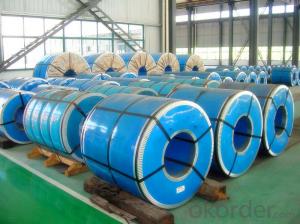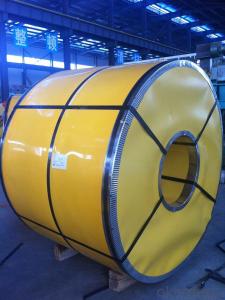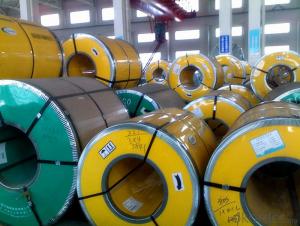Stainless Steel Coil 304 Hot Rolled Wide Strip No.1 Finish
OKorder Service Pledge
OKorder Financial Service
You Might Also Like
304 Stainless Steel Coil Hot Rolled Annealing and Pickling No.1 Finish Wide Strip
1.surface:NO.1
2.standard:JIS, AISI, GB
3.width: 0.55m
304 Stainless Steel Coil Hot Rolled Annealing and Pickling No.1 Finish Wide Strip Chemical Composition:
(%):C=0.07, Mn=2.00, P=0.045, S=0.030, Si=0.075, Cr=17.5-19.5, Ni=8.0-10.5, N=0.10
304 Stainless Steel Coil Hot Rolled Annealing and Pickling No.1 Finish Wide Strip Physical Properties
Tensile strength σb (MPa) ≥ 520
the conditions yield strength σ0.2 (MPa) ≥ 205,
elongation δ5 (%) ≥ 40
Reduction of ψ (%) ≥ 50,
hardness: ≤ 187
HB; ≤ 90
HRB; ≤ 200H
304 Stainless Steel Coil Hot Rolled Annealing and Pickling No.1 Finish Wide Strip
Type | 304 Stainless Steel Coil Hot Rolled Annealing and Pickling No.1 Finish Wide Strip |
Thickness | 3.0mm-4.0mm |
Width | 1000mm, 1219mm, 1240mm, 1500mm |
Length | according to weight |
Brand name | CNBM |
Standard | ASTM, AISI, DIN, GB, JIS etc |
Material | 304 |
Application | Foodstuff, Gas, metallurgy, biology, electron, chemical, petroleum, boiler, nuclear energy, Medical equipment, fertilizer etc |
Package | Standard export sea-worthy packing |
Delivery time | Within 15 days since getting the deposit or LC origin |
Surface | NO.1 |
Productivity | 20000 tons/month |
- Q:What are the differences between hot-rolled and cold-rolled 111 stainless steel strips?
- Hot-rolled and cold-rolled 111 stainless steel strips differ primarily in the manufacturing process and resulting characteristics. Hot-rolled strips are formed at high temperatures, making them more malleable and less brittle. They have a rougher surface finish and may exhibit a scaled appearance. On the other hand, cold-rolled strips are processed at room temperature, resulting in a smoother finish with tighter tolerances. They are generally stronger and have improved dimensional accuracy. Overall, the choice between hot-rolled and cold-rolled 111 stainless steel strips depends on specific application requirements.
- Q:Can stainless steel strips be used for electrical enclosures?
- Yes, stainless steel strips can be used for electrical enclosures. Stainless steel is a highly durable and corrosion-resistant material, making it suitable for protecting electrical components from external elements and providing long-term reliability.
- Q:Can stainless steel strips be used for decorative screens?
- Yes, stainless steel strips can be used for decorative screens. Stainless steel is a versatile material that offers both durability and aesthetic appeal, making it a popular choice for various applications, including decorative screens. The strips can be cut and shaped into different patterns or designs, allowing for creative and customized screen options. Additionally, stainless steel is resistant to corrosion and can withstand outdoor elements, making it suitable for both indoor and outdoor decorative screens. Whether it's for privacy, partitioning, or enhancing the visual appeal of a space, stainless steel strips can be an excellent choice for creating decorative screens.
- Q:How do stainless steel strips handle exposure to chlorine?
- Stainless steel strips possess an exceptional ability to withstand corrosion and effectively endure chlorine exposure. Given that chlorine is an exceedingly reactive element capable of inducing corrosion in numerous metals, stainless steel sets itself apart by containing a substantial quantity of chromium. This chromium content enables the formation of a protective oxide layer on the surface of the stainless steel, acting as a formidable barrier that thwarts chlorine from accessing the underlying metal. Consequently, the stainless steel strip remains shielded from corrosion. Furthermore, stainless steel boasts the presence of additional alloying elements such as nickel and molybdenum, which further bolster its corrosion resistance in chlorine-rich surroundings. All in all, stainless steel strips emerge as an outstanding choice for applications involving chlorine exposure, as they retain their strength and integrity even in the harshest conditions.
- Q:Are stainless steel strips resistant to fire and high temperatures?
- Yes, stainless steel strips are highly resistant to fire and high temperatures. Stainless steel is a type of steel alloy that contains chromium, which forms a protective oxide layer on the surface of the metal. This oxide layer makes stainless steel highly resistant to corrosion, heat, and fire. Stainless steel can withstand high temperatures without losing its strength or becoming deformed, which makes it an ideal material for applications that involve exposure to fire or extreme heat. Additionally, stainless steel has a high melting point, typically around 1370-1400 degrees Celsius, which further contributes to its fire and heat resistance properties.
- Q:How are stainless steel strips different from galvanized steel strips?
- Stainless steel strips differ from galvanized steel strips primarily in terms of their composition and the way they are protected against corrosion. Stainless steel strips are made from an alloy of iron and chromium, which provides excellent resistance to rust and corrosion without the need for additional coatings. On the other hand, galvanized steel strips are made from regular steel that is coated with a layer of zinc to protect it from rust and corrosion. This zinc coating acts as a sacrificial layer, meaning it corrodes first before the steel underneath, providing a certain level of protection. However, stainless steel strips generally offer superior corrosion resistance and are more suitable for applications where long-term durability and resistance to harsh environments are required.
- Q:Can stainless steel strips be used for electrical connectors?
- Yes, stainless steel strips can be used for electrical connectors. Stainless steel is a versatile material that offers excellent electrical conductivity, corrosion resistance, and mechanical strength. These properties make it suitable for various applications, including electrical connectors. Stainless steel strips can be formed into different shapes, such as pins or terminals, and can be used to establish electrical connections between components or wires. Additionally, stainless steel is widely used in electrical connectors for its durability and ability to withstand high temperatures, making it a reliable choice for many electrical systems.
- Q:Are stainless steel strips suitable for decorative purposes?
- Yes, stainless steel strips are suitable for decorative purposes. Stainless steel is known for its sleek and modern appearance, making it a popular choice for various decorative applications. It has a shiny and reflective surface that adds a touch of elegance to any space. Stainless steel strips can be used to create decorative accents such as trim, borders, or even custom designs on walls, furniture, or appliances. Its durability and resistance to corrosion make it a long-lasting option for both indoor and outdoor use. Additionally, stainless steel is easy to clean and maintain, ensuring that its decorative qualities remain intact over time. Overall, stainless steel strips are a versatile and aesthetically pleasing choice for decorative purposes.
- Q:Can stainless steel strips be easily welded?
- Yes, stainless steel strips can be easily welded. Stainless steel is known for its excellent weldability due to its high melting point, low thermal conductivity, and good heat resistance. The most commonly used welding methods for stainless steel strips include TIG (Tungsten Inert Gas) welding and MIG (Metal Inert Gas) welding. These methods allow for precise control of the welding process and produce strong and durable welds. Additionally, stainless steel strips are often used in various industries, including automotive, construction, and manufacturing, where welding is a common joining technique.
- Q:Can stainless steel strips be used in oil and gas applications?
- Yes, stainless steel strips can be used in oil and gas applications. Stainless steel offers excellent resistance to corrosion and high temperature, making it suitable for various components in the oil and gas industry such as pipelines, tanks, and valves. Its durability and strength make stainless steel strips a reliable choice for these demanding applications.
1. Manufacturer Overview |
|
|---|---|
| Location | |
| Year Established | |
| Annual Output Value | |
| Main Markets | |
| Company Certifications | |
2. Manufacturer Certificates |
|
|---|---|
| a) Certification Name | |
| Range | |
| Reference | |
| Validity Period | |
3. Manufacturer Capability |
|
|---|---|
| a)Trade Capacity | |
| Nearest Port | |
| Export Percentage | |
| No.of Employees in Trade Department | |
| Language Spoken: | |
| b)Factory Information | |
| Factory Size: | |
| No. of Production Lines | |
| Contract Manufacturing | |
| Product Price Range | |
Send your message to us
Stainless Steel Coil 304 Hot Rolled Wide Strip No.1 Finish
OKorder Service Pledge
OKorder Financial Service
Similar products
New products
Hot products
Related keywords





























